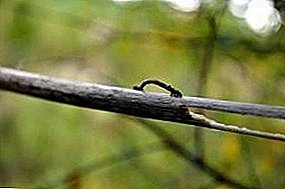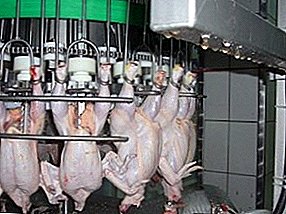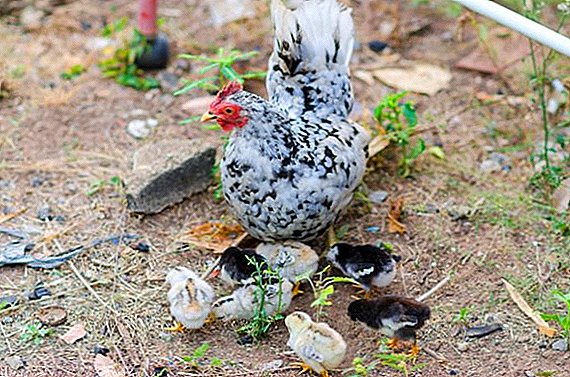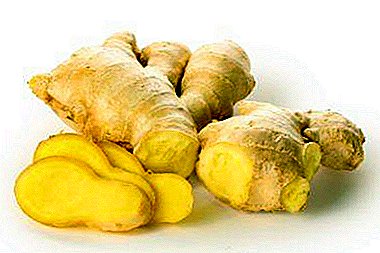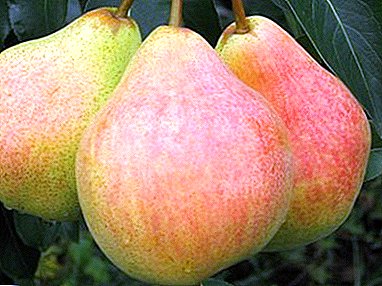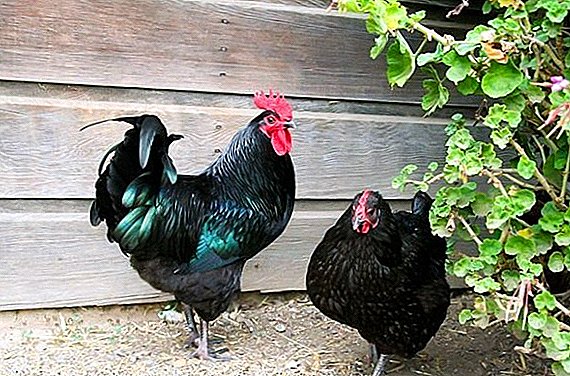 The breed of chickens Jersey giant, in all likelihood, is the largest in the world. Although it was bred back in the 20s of the last century, people in our area learned about it relatively recently, and the breed immediately attracted the attention of poultry farmers. This material is devoted to the description of the breed and the characteristics of its content.
The breed of chickens Jersey giant, in all likelihood, is the largest in the world. Although it was bred back in the 20s of the last century, people in our area learned about it relatively recently, and the breed immediately attracted the attention of poultry farmers. This material is devoted to the description of the breed and the characteristics of its content.
Breed origin
It is assumed that the work on the breeding of this breed began in the late XIX century. For the creation of the Jersey giant, such breeds as Brama, Black Java, Black Langshan and Orpington were crossed. The first representatives of the breed brought American breeder Ukham Dexter in 1915. 
Later, during the 20s, work continued on improving the breed, which eventually ended in success.
Did you know? Chinese silk chickens are distinguished by very dark meat and dark bones. Their Chinese name, Wu Go Ji, is translated as "hens with black bones." Silk they are called for a special silky plumage. The meat of these chickens is traditionally used in Chinese medicine.
Description of appearance and temperament
Initially, the Jersey giant was black, but subsequently varieties of white and ash blue colors were derived. This is a large bird, whose weight reaches 7 kg - such a weight can be gained by males, smaller samochki, they weigh up to 5 kg.
The rooster has a large head, adorned with six-pronged red scallops, red earlobes and earrings. Chest massive, wide. The paws are four-fingered, may be gray or black, the thigh and shin are well developed, the tail is lush, consists of sickle-shaped feathers. 
Chickens are more squat, their tails are not so lush compared to the tails of roosters, but also beautiful. As for the nature of the representatives of the breed, their calm and balanced behavior is noted.
Productivity characteristic
This breed is primarily meat. The rooster can gain 6-7 kg weight, and the chicken weight is 4-5 kg. With the "meat" orientation giants have not lost the ability to good egg production. Chickens start running at about seven months of age.
Check out the ranking of the most meaty breeds, egg breeds of chickens, the best breeds of broilers, and also learn about the content of such breeds of chickens as Poltava, Leghorn, Rhode Island, Foxy Chick, golosheyk, Russian White Belaya, Bielefelder, Kuban Red, Hubbard, Amrox, Maran, Master Gray.
Egg size is relatively small - first there are specimens weighing 55-60 g, a little later their weight increases to about 70 g. During the first year, the chicken can carry up to 180 eggs, later on its productivity decreases. 
Growth and weight gain
Active weight gain is observed in the first six months of life of these chickens, then the intensity of the process is markedly reduced, although the weight gain does not stop until one and a half years. For six months, the rooster can gain a 5-kilogram mass, and the chicken - 3.5-4 kg.
Usually, birds raised for meat are slaughtered by 6 months, otherwise their content becomes unprofitable.
Advantages and disadvantages of the breed
This breed has both undoubted advantages and some disadvantages.
The advantages include:
- significant yield of quality meat;
- quick weight gain;
- disease resistance;
- high chick survival rate;
- good egg production.

The breed has certain disadvantages, namely:
- increased feed consumption;
- the need for increased walking space;
- because of the weight of the hen, eggs are often crushed.
Features of the content of giants
The content of the Jersey giants is not particularly difficult, but it still has its own characteristics that must be taken into account.
Conditions of detention
Jersey can be in a hen house all year round, but it is optimal for them to arrange walking in the warm season. The walking conditions are described below. As for the chicken coop, the norm should be observed there - no more than two individuals per square meter of the area of the enclosure.
At the same time it is necessary to organize natural and artificial lighting of the open-air cage, access of fresh air. 
Perfumes suit low, because a heavy body does not allow the Jersey to jump high. The litter should be soft. It is also advisable to arrange in the nests chutes for eggs, because massive hens often crush them with their bodies.
Feeding
To feed the Jersey breed they use mixed fodder, which must be supplemented with shell rock, limestone and chalk. Jersey fed 2-3 times a day. A typical formula for feeding consists of coarse grains and additives: 40% corn; 40% wheat; 20% of meal, cake, shell rock, chalk, vitamin supplements.
If you organize walking the Jersey, in a warm period, the cost of food can be significantly reduced.
Requirements for walking
The organization of daily walking has a good effect on the development of the Jersey breed. 
Since the birds are heavy and not able to flip through high obstacles, you can install a low fence. These birds eat everything: grass, insects, seeds.
This eliminates the need for vitamin supplements, and, in addition, significantly reduced the cost of feeding, in some cases more than two-thirds.
Conditions for winter
These birds tolerate even severe winters without any problems, provided that the temperature in the hen house is positive, not below +5 ° С. The optimum temperature is +10 ° C. It is also necessary to provide bedding of straw or sawdust, and, in addition, good ventilation.
Important! In winter, the scallop is a vulnerable spot for the Jersey breed. Already at zero temperature, it can be damaged, so it is advisable to keep these birds in winter only in warmed rooms.

Content of hens
To ensure maximum egg production, it is important not to overfeed the hens, otherwise their productivity decreases. It is recommended to add shell rock, sand and limestone to the fodder of the hens; it is best to arrange a separate feeder with this mixture.
Find out why chickens peck eggs, which vitamins are needed for laying hens, why chickens carry small eggs, and also why chickens do not rush, how to make a roost for laying hens.
Since Jersey often squeezes laid eggs, their nests are equipped with stingrays for eggs. Daily egg walking has a positive effect on the egg production of this breed. In winter, the productivity of layers is practically not reduced.
Did you know? In 1971, in the United States and in 1977, in the USSR, chickens laid an egg, in which as many as nine yolks were found in each.
Care for the young
The first two months of chickens are kept separately, in a bright, dry room without drafts. The optimum temperature is + 25 ... +28 ° С. As feed, they are given meal or cake, as well as additives containing calcium, fish meal, boiled root crops (potatoes or carrots). 
On the first day, chickens may not show interest in food, this may be due to the fact that they have not yet digested the nutrient mass contained in the eggs from which they hatched. Dry litter can serve as litter. It is also necessary to take care of drinking, the chickens constantly need warm boiled water.
Important! The first three days should feed the chickens with egg yolk taken from boiled chicken eggs. Consumption rate - one yolk per 20 chickens.
Health
Jersey giants are disease resistant, but as a preventive measure, chickens get antibiotics and anti-worms drugs. The most common disease is mycoplasmosis. This infection affects the respiratory organs and can lead to the death of the bird.
For treatment are used antibiotics "Farmazin", "Enroksil", "Tilmikovet", which are added to the troughs or mixed into the feed. 
As a preventive measure for mycoplasmosis, it is recommended to maintain cleanliness in the hen house, regularly disinfect it there, periodically change litter, provide ventilation. All new inhabitants of the coop must first be quarantined.
It will also be useful for you to learn about the peculiarities of keeping chickens in cages, how to make a cage for chickens yourself.
Various parasites can become a problem for the bird: ticks, fleas, perojedy (they are also "chicken lice"). A good way to prevent these parasites is the device trays of ash. For this, a trough is usually used, in which sand and ash are poured in equal parts. Mixture layer should be 20 cm.
As we see, it is not for nothing that Jersey giants are of interest to the poultry farmers. This meat breed is distinguished by a significant weight and rapid weight gain, in addition, it has decent egg production and resistance to diseases. 
The maintenance of breed does not cause any difficulties, it perfectly is suitable for small farms and private farmsteads.




